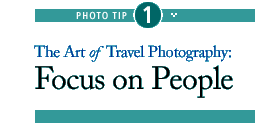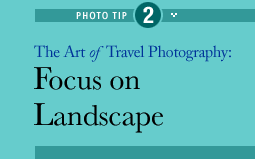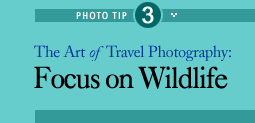�          
|  | �
For well over a decade, Peter Guttman has given photographic seminars and courses to aspiring artists, cultural groups and student workshops all over the world. His instructive discussions have been seen on national media and television tours for Kodak, an exclusive chapter in the Kodak Guide to Shooting Great Travel Pictures and as a feature on the Travel Channel's Almanac of Travel with Arthur Frommer. As well, he has taught a popular course on travel photography at the renowned International Center of Photography in New York City. Here will be presented a rotating course of photography tips for aesthetically inclined nomads. | |
| | |
 |  | |
      | |
| | |
| | | | | |
| What turns a mere snapshot into a portrait that really matters? | | Photography is about how you see the world, about the way you reveal your vision. The special key to unlocking the secrets of unfamiliar cultures and regions is to reveal the people behind the place. Opportunities to capture those people on film can't always be planned or staged, though. In fact, the most serendipitous moments in travel frequently occur when you meet people on the road, and your camera captures something quite unexpected. A camera can sometimes help break the ice, but by far the most essential tools for taking memorable, moving portraits are your eyes and the thought you put into developing a unique perspective.
There are no hard and fast rules for taking arresting photographs of people, but there are a few basic rules worth following. Spend time with your subjects to gain their trust � be warm, polite, and respectful of their traditions. Give people a sense of participation by allowing them to look through your lens or by giving them a Polaroid of their image. Get better eye contact by taking your eye out of the viewfinder while clicking the shutter, and be quick to respond to movements and gestures that will give a natural life to your shots.
Taking photographs offers a chance to explore hidden worlds and an opportunity to capture the human experience in a visual language comprehensible to us all.With that in mind, there are more specific ways in which you can train your eye:
| |
| | | |
| | | | | |
| | | | | | |
|  | | | | |  |
| | | |
| | |
 |  | |
      | |
| | |
| | | | | |
| What turns scenery into a landscape that really matters? | | Landscape photography provides a poetic rendering of the power, beauty and ethereal nature of our environment. Planet earth's infinite variety of ecosystems, weather conditions and seasonal variations as well as civilization's unending efforts to co-habitate amongst this diversity of settings yield a portrait of our globe that have transfixed artists for centuries. Observing and recording the details of our surroundings enable us to heighten our sensitivity to the precious fragility of this changing world. | |
|
| | | | | | |
| | | |
| | |
 |  | |
      |
| | |
| | | | | |
| What turns the next safari into an expedition that really matters? | | Wildlife photography draws the observer into a primal quest for the zoological niches that create such a rich spectrum of biodiversity here on earth. By studying and portraying the fascinating behavior and astonishing variety of animal life, we better appreciate the delicate beauty and adaptive ingenuity of nature's magnificent creatures. In the process, we develop an intuitive stewardship and sense of responsibility for protecting the countless vulnerable species with whom we share our planet.
| |
| | | |
| | | | | |
| | | | | | |
|  | | | | |  |





